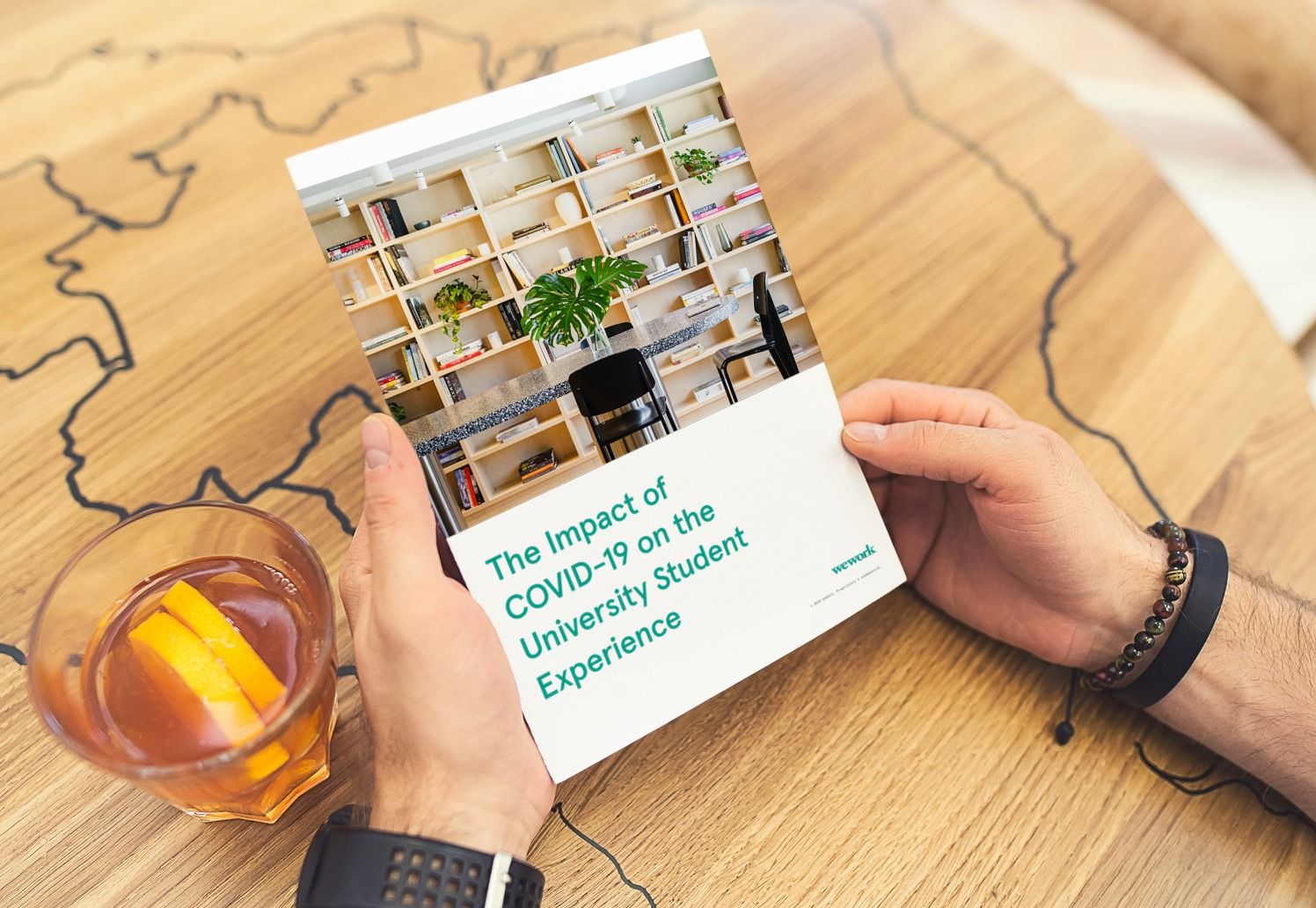A year of virtual education around the globe has transformed the university learning landscape and, perhaps, its future. At the same time, satisfaction among higher education students at universities that have remained online throughout the pandemic has taken a nose-dive.

Research by WeWork, in partnership with brightspot strategy, found that students continuing to learn remotely are struggling; satisfaction was half that of their on-campus counterparts in fall 2020, alongside a 23 per cent dip in coursework engagement. Findings also revealed that the two most important things that students value about university are ‘in-person classes’ and ‘being together with friends, proving that the benefits of campus life go beyond the classroom.
Meanwhile, hybrid students – those flexing between online and in-person learning - were 67 percent satisfied. So, could this model be the answer to harnessing the technology and benefits gleaned through remote pandemic learning while retaining student engagement? The experts in The (unsurprising?) changes coming to the education industry webinar, which formed part of the recent WeWork Innovation Summit, certainly thought it had the potential to do so.

In many respects, it’s the kind of change that education innovators have been advocating for some time. Covid merely slammed a foot on the gas. There’s long been a desire to bridge the gap between traditional residential college life and the success of models such as the Harvard Extension School to improve education quality and accessibility.
More WeWork-style spaces – both on and off-campus – could well step into this now-expanding sphere. Not only do they enable students to transcend time and place to learn, but they also exude the buzz and social benefits of being around peers that so many have been missing. Co-working is no longer just for corporates; the model is part of the future for higher education.
Campus futures
Pre-pandemic, about five to 10 percent of learning among traditional college age students was done remotely, according to Dr Peter Temes, Founder and President of the Institute for Innovation in Large Organizations. Now, it’s at least 50 per cent but, by next fall, it is likely to level off at about 25 per cent.
But, while many students are keen to return to fully-fledged university life, aspects of virtual learning and the subsequent re-thinking of campus spaces are here to stay.
Thanks to pandemic re-purposing, it could be argued that campuses are gradually edging towards becoming more like co-working spaces. The days of libraries being a silent labyrinth of bookshelves are long gone, for instance, they’re now thriving, multi-purpose spaces for students to work, focus, collaborate, and communicate in, with cutting edge technology and often much-needed coffee shops to refuel weary brains.
And universities, like Northeastern have developed online platforms for students to book desk space anywhere from libraries to disused admin offices. Northeastern has also outfitted 170 classrooms under a 'new flex' model with advanced microphones and cameras to allow both faculty and students to participate remotely or in person.
Global learning spaces
Other institutions, where international students may continue to be impacted for some time to come, have developed a global network of bookable desk space at partner institutions.
Some have in fact, have set up satellite campuses worldwide, such as New York University, which needed to accommodate 3,000 students in Shanghai using facilities usually used for commercial co-working.
It all feeds into the concept of giving students deskspace away from the kitchen table or sofa, wherever they are in the world, at least for the short term.
This may or may not be sustainable in a post-Covid word, of course, but it does highlight the opportunities that lie ahead in giving distanced learning a whole new meaning, where borders and time zones are no longer be a barrier to the very best that higher education has to offer.

Or, maybe, as Wharton professor Adam Grant suggests in his Why we should 'kill the university' blog, “could we build a consortium of universities with shared talent that could teach all over the world?” A frightening thought for some, and maybe refreshing thinking for others.
We’ve mentioned WeWork in this article and their new research hot off the press reports that the students surveyed who had access to a location away from their home and campus to use as a learning environment, such as a café or co-working space, rated their academic performance above average, and they valued their campuses’ ability to make them feel part of a community the highest.
It goes without saying that not all students have space or technology conducive to study at home or in dorm environments, and many are likely to be looking for that in the future. Helping them with this is something universities will want to explore more in the next few years.
The few students who had access to a "third place," a location outside their home and campus that could serve as a learning environment, such as a café or co-working space, rated their academic performance above average. These students had the highest likelihood of recommending their university to a friend; and none of them were detractors of their university.
They rated their campuses' ability to make them feel part of a community the highest among all students surveyed.
A new marketing opportunity
Hybrid learning is clearly here to stay – albeit at varying, Covid-dependent levels. And, for many students, the flexibility this offers will be a major draw. In fact, this new concept of studying at a time and place to suit could even open university learning up to those for whom it was perhaps inaccessible before – like parents unable to afford childcare, for example.
So, universities that think smart and tailor marketing to tap into this newfound appetite for flexibility and hybrid learning could well reap the rewards, but few seem to be tapping into this as a unique selling point so far.

Northeastern NUFLEX is leading the pack in prominently marketing their graduate programs in on-campus, online or hybrid formats. Most other institutions on a digital front continue to look ahead to normal campus life, but with so many exciting adaptations and innovations that now gear universities up to the new paradigm of hybrid working, it seems like a missed opportunity not to bring that option into the fold. Ongoing concerns about the costs could be a factor.
At what cost?
A shift towards more flexible learning and the improved accessibility this could bring is undoubtedly a positive, but one tinged with concerns over the implications for university finances.
The thinking is that, long-term, pricing structures will change to reflect varying in-person interaction and faculty usage levels. This is where universities, including those already reeling from the sudden expenditure of equipping students and staff for remote working, need to up their game.
Under a hybrid model, universities need to create appealing co-study spaces where students want to come to learn, work and collaborate. Spaces that lure them in with a myriad of benefits, academic and social, over the draw of saving money and learning at a distance at home. Facilities where there is high-quality technology on tap alongside an ease of access to support staff.
Students need to feel empowered by this newfound flexibility in study and still feel like they belong in a physical space.
Innovation is crucial
Innovation will be key to financial viability when embracing a new world of online learning while satisfying a continued appetite for in-person student culture.
Campuses with big physical assets will need to think about how to use excess space creatively for out-of-classroom experiences and how to maximize the potential of on-site environments.
That focus on what makes on-campus life so special, loaded with opportunities to lead and grow outside of the classroom, is crucial.
Ultimately, the students of the future are agile and will vote with their feet. Adaptation is necessary. The institutions with a clear strategic marketing approach to communicating their unique hybrid offering could be set to benefit the most.
How has your university adapted to the challenges of online and in-person teaching? Are there specific marketing activities in place to communicate the benefits to prospects? And what part has technology played so far? We’d love to hear.

:format()//media/Hybrid-Learning-RQ.png)